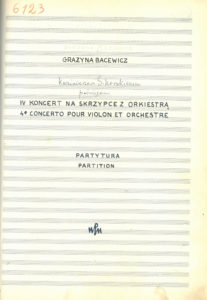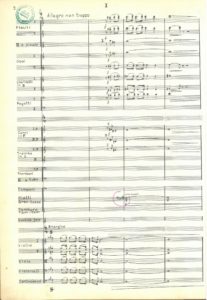In October 1951, shortly after the “Brussels victory”, as Grzegorz Fitelberg called the composer’s 1st Prize for String Quartet No. 4 received in Liège, Belgium, Grażyna Bacewicz gave an interview to Ekspress Wieczorny. Asked about what she was working on, she replied
At the moment I’m finishing my Violin Concerto No. 4 with orchestra, the premiere of which will probably take place in February, in one of our philharmonic halls. I’m also working on my Symphony No. 3.
Admirable work intensity. And yet that same year she also wrote, in addition to String Quartet No. 4, such important pieces as Symphony No. 2, Sonata No. 5 for violin and piano or Cello Concerto No. 1, not to mention several smaller pieces.
There is a puzzle associated with the Concerto and concerning its dedication. On the cover of the manuscript the composer wrote: “I dedicate it to Kazimierz Sikorski”. But the violin part and piano score published by PWM Edition contain the following inscription: “To Professor Józef Jarzębski”. Did the composer want to give her new work to her two professors?
Bacewicz’s Violin Concerto No. 4 does not enjoy the popularity it certainly deserves. Written in the classic, three-movement convention, it testifies to the composer’s strong attachment to tradition, but also to her freedom in shaping the mutual relations between the solo instrument and the orchestra. The composer does not seem to have given in to the pressure of the “cultural policy” of the day, a policy forcing the artists to adopt a traditionalist stance marked by a type of expression known as “new revolutionary romanticism”. A slight turn to the monumentalisation of sound can be discerned only at the beginning of the first movement (Allegro non troppo), an orchestral introduction in the “heroico” convention. This is contrasted with a quasi-improvised sequence of the solo instrument leading to the first theme. The swinging rhythm of the theme in 6/8 (dolce, espressivo) as well as an additional episode (bar 71, sonore) highlight the violin against an unobtrusive orchestral accompaniment. The classical rules are sanctioned by a brief orchestral link leading, through a cantabile of the oboes, to a presentation, again in the solo violin, of the second theme (bar 100, rubato) preceded, like the first theme, by a short introductory sequence and again developed in an evolutionary manner to highlight the virtuosic capabilities of the solo instrument. The elaborate exposition ends with a loud epilogue of an orchestral tutti drawing on the material from the introduction. The development takes place largely in an elaborate solo cadenza featuring not only the two lyrical main themes but also the characteristic “circular” secondary theme. In the recapitulation, over a section of 27 bars, the exposition of the first theme is repeated in an almost unchanged form with the exception of two slight changes which, however, seems like proofreading errors. The second theme appears in the recapitulation a ninth lower than in the exposition and – unlike the first theme – retains the outline of the original only by five full bars.
The second movement (Andante tranquillo), with its ABA1 form with two short violin cadenzas, is a romantic poem full of lyricism and pathos. A lyrical violin theme is woven against an orchestral accompaniment (initially dominated by the string quintet), which seems almost like a colourful patch made up of overlapping crotchet runs of thirds and seconds, occasionally fourths and sixths. This impressionistic, contemplative image becomes increasingly expressive in the following fragments, especially when the lead is taken over by the orchestra, which has a bigger say here than in the first movement.
The third movement (Vivace) takes the form of a brilliant, virtuosic sonata allegro with elements of a rondo, in which the mutual relation between the solo instrument and the orchestra is much closer than in the preceding movements. This is evidenced already by the first entry of the violin, emerging from the orchestra by “taking over” an octave-multiplied note D ending the orchestral introduction. The violin expands the note to staccato dyads which, together with short passages, constitute and introduction to a lively theme. The eight-bar theme, in a classic A+A1 formula, is quickly developed and transformed into the lyrical second theme (bar 87). In its initial phase the theme is a replica of the violin theme from the second movement of Violin Concerto No. 3! The first motif, apart from a different final note, is identical. The development, on the other hand, features an additional motif in the violin, with clear folk colours (bar 186), while the recapitulation is reversed. In comparison with the exposition, the second theme appears in the lower fifth (C–F), although this has nothing to do with the classic dominant-based relationship. The recapitulation features a brief violin cadenza based on motifs from the second theme. The concerto ends with a vigorous coda (from bar 316), featuring a reminder of the additional folk theme.
The classical form does not in any way tie up the composer’s invention, especially in the planning of the violin part, which sparkles with a wealth of articulation and changeability requiring a great deal of virtuosity – from various trills, tremolandos, glissandos to fast passages, staccatos, two-note runs, without looking for additional effects, like playing sul ponticello, which can be found in Bacewicz’s later works. We can hear here a reliable hand of the performer-composer, because Bacewicz wrote the piece primarily for herself and was the first performer of the Concerto, in a performance which took place on 21 February 1952 in Kraków. The Orchestra of the Kraków Philharmonic was conducted by Bohdan Wodiczko. It was the last concerto premiered by the composer. The decision, harboured for some time, to give up the stage and focus solely on composing would be taken after that premiere.
In the meantime Stefan Kisielewski, a faithful follower of Grażyna Bacewicz’s compositional endeavours, again did not fail to introduce the readers of Tygodnik Powszechny to the new work, for which the composer received the State Prize, 2nd class:
We are dealing here with one of the composer’s most outstanding achievements, worthy of being put right next to such works as her Violin Sonata No. 4, Concerto for Strings or Symphony No. 2. The works is very homogeneous in its nature, in its stylistic language: this is achieved thanks to an extraordinarily assured and thoughtful instrumentation; a harmonic palette more consistent and ‘audible’ than in some of her earlier pieces; finally, considerable weight in terms of the genre and thematic uniformity of style. This uniformity and consistency of the sound language combined with a clear and logical structure (there are plenty of intriguing formal ideas, especially in the development of the first movement) give the work marks of monumentality which, it seems, Bacewicz has been seeking for some time. That monumentality is austere: the brief orchestral introduction marks the whole atmosphere of the piece – slightly archaic, as it were, serious, at times even gloomy; that atmosphere is perfectly matched by the instrumentation, especially the use of the brass, which gives the orchestra a dark, sometimes (a tutti here and there) dense coulour, although this density is only apparent, it gets dissipated immediately with the entry of the violin, constantly dominating the whole – perfectly and comprehensively exploited…
The monumentalism attributed to the work by Kisiel, indeed manifested in the orchestral part, has been somewhat “demystified” by a brilliant performance of the Concerto (and the other five concertos) by Joanna Kurkowicz and the Polish Radio Orchestra conducted by Łukasz Borowicz (Polish Radio/Chandos Records). This interpretation highlights the virtuosic nature of the piece, its colourful texture, lightness and charm of the solo part and even a kind of musical wit (Vivace), inextricably linked to many of the composer’s works.
- Violin Concerto no. 4, PWM score, title page
- Violin Concerto no. 4, PWM score, mov. 1
- Violin Concerto no. 4, PWM score, mov. 2
- Violin Concerto no. 4, PWM score, mov. 3



